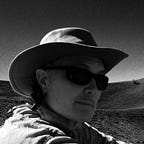Well Prepared For The Twentieth Century…
A long time ago — when I did a lot more of this sort of thing than I do now — a friend of mine sarcastically called me the Ansel Adams of the freeways. That swelled my head insufferably, of course — what True Californian wouldn’t want to be called the Ansel Adams of anything photographic?! (Well, maybe not “the Ansel Adams of pornography”, but even that’s got a certain allusive ring to it, conjuring up all sorts of images it probably shouldn’t…).
This photo is of the underside of part of what locals call “The Maze”, on the border between Oakland and Emeryville in California. It’s all pure structure. Somewhere in there or around me are Interstates 80, 880, and 580, and a bunch of on- and off-ramps. It was taken in the early-to-mid 1990’s, when earthquake damage to the old I-880 was being repaired or replaced at great expense; most of the roads you can see snaking above me weren’t actually in use at the time. Back then it was easy to take photos like this — there were usually no fences, and you just walked up (or rode your old mountain bike up, as I did) and took the photos. That’s a lot harder to do nowadays because of the security fences and guards, etc., and with all the police and concerned citizens on the lookout for terrorists like me taking photos of bridges or freeway over-crossings or the like. In this case I think I used a hand-held Mamiya 6x7 medium format rangefinder as my camera, but I couldn’t say for sure. Back then it would usually draw friendly comments from bystanders or passers-by; nowadays something like that’s more likely to get you assaulted, robbed, or arrested (at least in Oakland).
As I wrote about it when I first put this image online (a few years ago):
I’d dredge up the old Joan Didion quote about the freeways being “the only secular communion Los Angeles has” if this weren’t the Bay Area instead, and if I hadn’t already heard them called the great cathedrals of movement. Which always seemed more appropriate… until you’re stuck in traffic.
When I first moved to California I was actually impressed by the freeways. They delivered a mobility that I’d never had as a Londoner or Sydneysider (I’d never really owned a car in either of those places, but I’d certainly had to drive every now and then). Back when I moved here the freeways were still usually the fastest option for getting around the Bay Area, and going for a drive on them was something you might do for fun. There was traffic, but it wasn’t usually too bad, and jams were mostly limited to a few commute hours. The freeways felt like a liberation, in other words — not the deadening burden and tense drudgery they’ve become almost all day, every day nowadays for many people. I remember looking at a crumbling mid-2000’s version of Interstate 880 in Oakland and thinking “America’s so well prepared for the twentieth century!”. All those mid-century visions of mobility and personal freedom alive (or at least not yet totally dead) in the crumbling concrete and steel all around me. All those cars… going nowhere fast.
But the Mazes and freeways always interested me architecturally, and as an engineer: the curves, the lithe bony structures, the concrete-and-steel textures, the astonishing noise when you stand just beneath a busy fast-moving overhead freeway — all of those things sucked me in very quickly, and I spent a lot of time under the Maze and other structures like it taking photos. Most of which just weren’t very good, often because I had to do it all in a hurry, but a few of them have lasted over the years and decades. Often enough because, like these two images, almost everything in the photos has changed or gone away completely (and many of these structures have been strengthened over time against earthquakes, something you have to think seriously about here when you design structures like this). I can’t redo either of these shots now as a “then and now” series, mostly because I can’t access the same places I was while taking them back then — in one case it’s fenced in with tall barbed wire, in another there’s a building there now.
And it’s hard to argue with curves and structure as a photographic subject (and I don’t).
